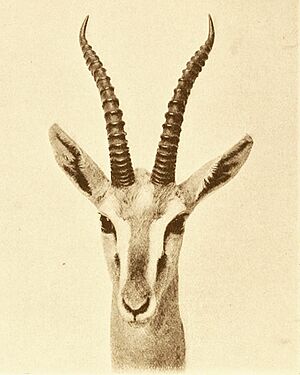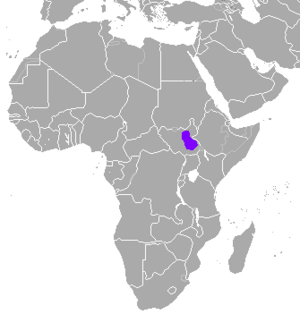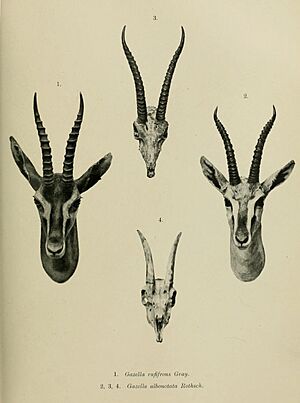Mongalla gazelle facts for kids
Quick facts for kids Mongalla gazelle |
|
|---|---|
 |
|
| Conservation status | |
| Scientific classification | |
| Genus: |
Eudorcas
|
| Species: |
albonotata
|
 |
|
| Range of the Mongalla gazelle | |
The Mongalla gazelle (Eudorcas albonotata) is a type of gazelle that lives in the grassy plains and floodplains of South Sudan. A British zoologist named Walter Rothschild first described it in 1903.
Scientists sometimes disagree about whether the Mongalla gazelle is its own unique monotypic species or a subspecies of another gazelle. Some think it is a subspecies of Thomson's gazelle, while others believe it is a subspecies of the red-fronted gazelle.
This gazelle is a medium-sized antelope. Its fur is brown, but its forehead, belly, and bottom are white. It has a bright, wide stripe on its side, with a reddish-brown one just below it. Both male and female gazelles have horns, but the male's horns are twice as long as the female's.
Mongalla gazelles live in the flat savannas and floodplains of South Sudan, east of the Nile River. They do not live near the borders of Kenya and Uganda. The International Union for Conservation of Nature and Natural Resources (IUCN) says the Mongalla gazelle is of Least Concern. This means it is not currently in danger of disappearing.
Contents
About the Mongalla Gazelle's Name
The scientific name for the Mongalla gazelle is Eudorcas albonotata. It was first described by a British animal expert, Walter Rothschild, in 1903.
Scientists have different ideas about how to classify the Mongalla gazelle. Some experts, like Alan W. Gentry, think it is a subspecies of Thomson's gazelle (Eudorcas thomsonii). Other scientists, like Colin Groves, believe Thomson's gazelle is the same species as the red-fronted gazelle (E. rufifrons). Because of this, the Mongalla gazelle is sometimes listed as a subspecies of the red-fronted gazelle.
However, in 2011, scientists Grubb and Groves wrote that they believe the Mongalla gazelle is its own full species. They placed it in the group Eudorcas.
The common name "Mongalla gazelle" comes from Mongalla, a town in South Sudan.
What the Mongalla Gazelle Looks Like
The Mongalla gazelle is a medium-sized antelope. Males and females look a bit different, which is called being sexually dimorphic.
Its forehead is completely white, and each eye has a white ring around it. The area between its eyes and mouth is a light brown to black color. Its ears are pointed at the tips. The gazelle has a brown coat with a white belly and bottom. It has a wide band across its sides and a lighter reddish-brown one below it. There are also bands on its back and a stripe on its face.
The hair tufts on its knees are quite large. Its short tail is covered in hair. Both male and female gazelles have horns. The male's horns are short and have clear rings. The female's horns are only half as long as the males' and are thin and straight. The horns curve backward and then forward, with the tips turning slightly inward.
This gazelle is similar in size to the red-fronted gazelle. However, the Mongalla gazelle has a narrower skull. Also, in Mongalla gazelles, female horns are 50 percent shorter than male horns. In red-fronted gazelles, female horns are 60 to 70 percent shorter. The Mongalla gazelle also has a reddish-brown to black nose and face stripe, unlike the sandy to reddish-brown color of the red-fronted gazelle.
Where the Mongalla Gazelle Lives
The Mongalla gazelle lives in the floodplains and flat savanna grasslands of southeastern South Sudan, east of the Nile River. Its home range does not reach the borders of Kenya and Uganda.
In 1999, an expert named Rod East estimated there were about 100,000 Mongalla gazelles. However, the numbers can change a lot, and some areas are hard to reach. A survey in 2007 counted about 278,000 gazelles in parts of South Sudan.
These animals travel in a yearly cycle across the eastern Sudd floodplains. During the wet season, many Mongalla gazelles gather together. They join other animals that migrate, like the white-eared kob and tiang. Even with nearly 30 years of civil war in South Sudan, about 1.2 million white-eared kob, tiang, and Mongalla gazelles have continued their migration. In 2007, the Mongalla gazelle was the second most common animal in the Boma area.
Threats and How We Protect Them
The International Union for Conservation of Nature and Natural Resources (IUCN) has listed the Mongalla gazelle as a species of Least Concern. This means they are not currently facing a big risk of disappearing.
There are no major threats to the survival of this gazelle right now. The number of gazelles in the Boma area is stable. They are not at a high risk from hunting. Also, hunters have limited access to some parts of the gazelle's home range because there is no water in those areas.



